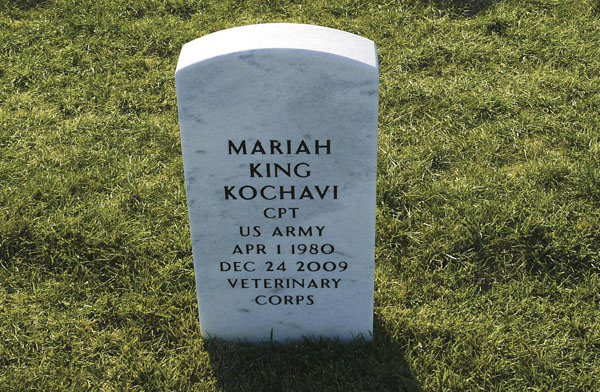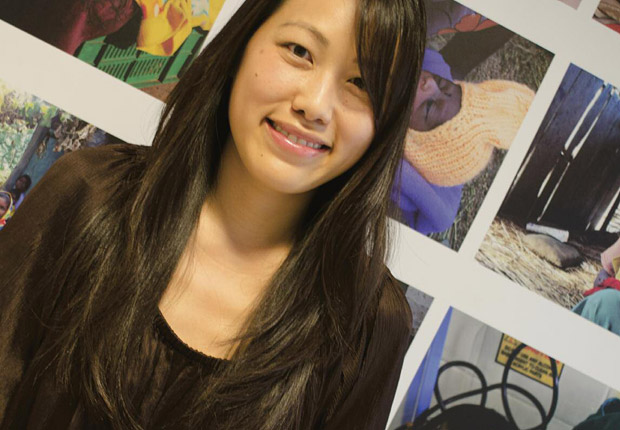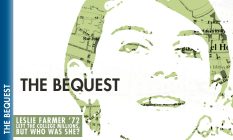
Leslie Farmer was a young woman on edge, awkward and eccentric, someone who didn’t fit in easily. Classmates who entered Pomona with her in 1963 recall Leslie as something of an outsider by choice—if they recall her at all. “I don’t remember seeing her interacting companionably with anyone else,” wrote one contemporary in response to my query on the class of ’67 listserv. Another could only remember her name and seeing her “lookbook” photo, but nothing particular about Leslie. Yet another classmate only had a memory of meeting Leslie in passing.
Some of Leslie’s obscurity likely stemmed from the fact that she left Pomona as a junior for a one-semester study abroad in Beirut and didn’t return for five years, staying on as a freelance reporter. But even in Lebanon, where you’d expect American expats to share a sense of camaraderie, she was hard to get to know. Editor Bill Tracy and illustrator Penny Williams-Yaqub worked with her in Beirut, and were surprised at how little they could recall of Leslie on a personal level. “Bill and I are always very interested in people,’’ says Williams-Yaqub, adding that, looking back, they both were stunned “that we didn’t know more about her.”
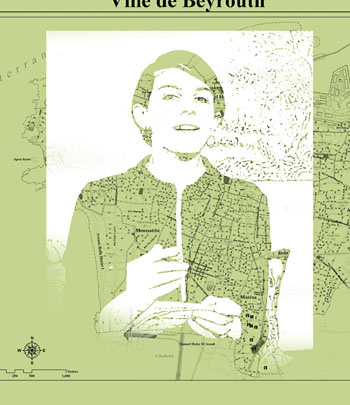
After she died in 2007, enigmatic Leslie left one more mystery. As the details of her estate were sorted out over months and then years, it emerged that Leslie had bequeathed millions of dollars to the College. The gift was unexpected—she had never tipped the College to her plans—and Leslie had had scant contact with Pomona in recent years. News of Leslie’s out-of-nowhere bequest, along with mention of her unusual stint in the Middle East as a student, eventually crossed my desk and set off my quest to learn more about her.
Leslie’s social seclusion and the lack of any close living relatives— she was single, an only child and both of her parents are deceased—meant some aspects of her life remained beyond reach. But her love for writing made it possible to piece together a lot of Leslie’s story from her many flecks of commentary and personal reflection still scattered around the web. It also helped that Leslie did indeed go on to forge a few lasting ties with people over the years and that, once again through the wonders of the web, some of the people who knew her best still could be found.
The Leslie Farmer found here was a talented writer, green-thumbed gardener, chronic book hoarder, pointed observer, fearless explorer of cultures and a lover of languages (studying Arabic, Czech, French and Italian at different points). It seems she could get swept up in just about anything that had to do with the life of the mind. But she also struggled to find her footing in life, following her intellectual fancies as a sort of eternal grad student. She saw the world: Her story reaches from Los Angeles to Beirut, from sand-swept Arabia to the cobblestone streets of Prague, and finally to the Garden District of New Orleans and the imposing, columned home where she died. And if Leslie never quite overcame her afflictions and limitations, she certainly did defy them. Tracy, one of Leslie’s Beirut editors, didn’t get to know her well, but he was on to something about Leslie from the start: “The first time I met her, she was painfully shy and very quiet. And yet there she was, a single woman traveling in Beirut, Lebanon … I thought, ‘there’s something here, she’s got some courage and guts.’”
LESLIE HELM FARMER WAS BORN in 1945 in Los Angeles to society-page parents and, no doubt, to plenty of drama, right from the start. Her mother was a former movie actress, Fay Helm, who appeared in dozens of films in the ’30s and ’40s, typically in smaller character parts but also in some larger roles, including one in the still-admired film noir thriller Phantom Lady (“A night he could not forget … with a woman he could not remember!”). Leslie’s biological father Jack Hardy was a prominent L.A. attorney, often in the papers, who earned the most ink for the sensational murder trial in which he won acquittal for a wife who had helped kill her brutally violent husband with a meat cleaver.
Fay and Jack Hardy divorced, not-so-amicably, shortly after Leslie was born, and Leslie would later write of how she had only seen her birth-father in a picture and had never met his family. Fay quickly remarried and, by all accounts, Leslie adored her adoptive father, Albert O. Farmer, a Beverly Hills dentist. The family lived in the rustic Mandeville Canyon neighborhood of Brentwood, and Leslie had a palomino named King and what sounded, in many ways, like an idyllic life. Years later, Leslie wrote a tribute to Albert’s gentleness and decency, praising how he could be a “‘man’s man’ and still not be a boor, a bully or domestic tyrant.” She tells of celebrating her 10th birthday in London, where her father bought her a carved wood swan she spotted in an antique shop.
But the next year, when Leslie was only 11, her father was hospitalized for a hernia operation. “Forty-eight hours later he was dead, victim of a rare blood cancer that was kicked into acute mode by the surgery,” Leslie wrote in an online posting many years later. From then on, it was just Leslie and mom. To put it succinctly, they were not close, at least by Leslie’s account.
As a teen, Leslie attended the private Westlake School for Girls in L.A., and then gained admission to Pomona. It’s not clear how Leslie decided to go to Lebanon (the 1964 Metate makes fleeting reference to her performing “songs from the Near East” at the five-college Smudge Pot Coffee House). Alan Hayes ’67 does recall that the intense and pale-looking Leslie had an interest in Islam, which was very unusual at the time, and that she once asked a Jewish student whether he spoke Arabic. According to Hayes: “Some people who were in that conversation later spoke of this as an example of Leslie’s social ineptitude, which I suppose it was, but I thought it was kind of charming all the same.”
Hayes, in fact, is the first person I came across who saw something more in Leslie, recalling her as “an original … and kind of complicated, which is to say confused, which struck me at the time, being a floundering adolescent myself, as an appealing authenticity.” And maybe Pomona as an institution saw something too: She would become the first Pomona student to study in the Middle East as part of the Experiment in International Living, according to articles from the time.
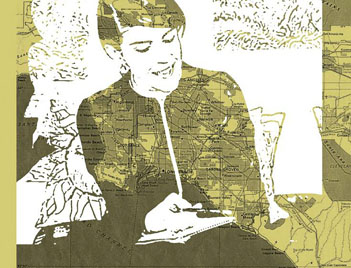
In Beirut, she took university Arabic classes and stayed with a young Lebanese woman named Fatima and her mother, forging a friendship Leslie would never forget. “Fatima was liberal, pretty, intelligent and not over-concerned at that time with religion or politics,” Leslie wrote in a letter decades later. When her one-semester study abroad was up, Leslie decided to stay. Maybe it was an easy choice: Bill Tracy, then an editor at Aramco World Magazine, recalls Beirut at that time was the place to be in the Middle East, a city so cosmopolitan that someone chatting at a cocktail party might shift from French to Arabic to English in the same sentence. There was plenty of work for journalists, as the city was home to dozens of newspapers. Among the papers she reported for from Egypt and Jordan as well as Lebanon was the Beirut Daily Star, the top English-language paper read throughout the Middle East. Aramco World, which reported on the region with funding from the massive Arabian American Oil Company, provided what might have been her most memorable assignment (still found online at www.saudiaramcoworld.com) in which she traveled across Saudi Arabia for a piece for a special issue about women in the Arab world.
“When the last vestings of the veil have disappeared, those who regret its passing will, I think, be few, symbolizing, as it does, the shadow of a time when women from the lowest to the highest, the most educated to the illiterate, were begrudged not only freedom of marriage, of association, of movement, but even the light of day,” was Leslie’s poetic ending to a piece titled “The Veil: A Darkness at Noon.”
The Arabian journey was unusual for a Western woman and, Tracy says, Leslie had to carry a letter of introduction from Aramco. “It was a little iffy,” adds her long-ago editor. She traveled with the illustrator Williams-Yaqub who recalls Leslie was “very edgy,” and then volunteers a thought: “I don’t know if she was stable. I’m not sure.” But Leslie pulled off the assignment, writing the lead-off piece for the issue, which on the cover featured a Saudi woman at school in Lebanon wearing large sunglasses instead of a veil. “Leslie is one of the few people, when she wrote something, the editor didn’t really play with it,” says Tracy, going on to note that her pieces always had the right beginning, middle and climax. “It was just structured exactly the way it was supposed to be.”
LESLIE’S OWN STORY DOESN’T hold together quite so neatly and proportionately. It is known that Leslie came home from the Middle East by 1971 and Pomona allowed her to resume her studies, which was no sure thing after five years away. She graduated with the Class of ’72 with a degree in English. After that she settled in the San Francisco Bay Area, but her undertakings for the next two decades can only be lightly traced with help from a few scattered class notes she submitted to this magazine. In 1976, she wrote in to say she was pursuing her master’s in communications at Stanford: “I have just sent out a fresh flock of poems to various magazines, and while awaiting the first rejection slip, am growing bulbs indoors and learning to play the corrugahorn.” Two years later, she reported she was doing much the same thing—writing poems and sending “I-toldyou-so letters” to editors regarding Lebanon after civil war broke out there— except she had now dropped out of Stanford.
Perhaps it is no coincidence that it was in 1991, near the end of this long, possibly difficult period, when her time at Pomona and in the Middle East may have seemed more and more seminal, that she laid out her estate plans. Half would go to the College and the other half to Fatima, the old friend from Lebanon she had kept in correspondence with. Leslie’s last class note, in 1992, is particularly cryptic, as she writes of hoping to “bench press her own weight and see spring in Damascus in the forseeable [sic] future.”
Within a few years Leslie would indeed find her spring, though in Prague instead of Damascus. The mid-’90s would bring Leslie a new obsession—the Czech Republic—and a new friend. And if her interest in Eastern Europe seemed to come out of nowhere, her friend Jarmila Marie Skalna explains that Leslie’s Czech obsession had roots in … Beirut.
During Leslie’s time there, decades earlier, she heard the news that a 20-year-old student named Jan Palach had lit himself on fire in Prague’s central square to protest the Soviet invasion that snuffed out then-Czechoslovakia’s growing democracy movement.Palach was a few years younger than Leslie, and she was captivated by the idea that someone that age could make such a statement. Leslie’s glimmer of interest was pushed aside by other matters until, somehow, it was rekindled decades later and she went looking for someone to teach her Czech. She was referred to Skalna, a Czech writer who with her husband left her homeland and settled in the Bay Area a decade earlier. The lessons were fruitful. “She learned Czech incredibly fast and well,” says Skalna.

In 1995, Leslie made her first trip to Prague and, as Skalna recounts, she was enthralled, even leaving a poem she had written about Palach at a monument to the Czech martyr. Upon her return home, Leslie delved deeper into all things Czech: music, films and the writers Kundera and Capek. She worked and worked on her own, perhaps-never-finished book getting inside the minds of two doomed Czech soldiers as they holed up inside a church after assassinating SS leader Reinhold Heydrich in a famous World War II incident.
In this productive phase in her life, Leslie finally went back to complete her master’s degree—Skalna suggests Leslie was trying to please her mother—at San Jose State. She kept returning to the Czech Republic, managing to connect her obsession there to her work back in grad school. “I was so astounded and ravished by the baroque architecture of Prague that I somehow persuaded my department to let me do a long magazine article on historic restoration in Prague as my thesis,” Leslie wrote online. Leslie visited the Czech Republic for a third time, in 1997, this time to study the language at a school in Brno in south Moravia. She did quite well, making it to the highest level of the beginner program, and she kept in touch with Skalna by email. “She was very happy there,” says Skalna.
Leslie’s happiness came despite what Skalna calls her “obvious social problems,” and some of the students at the Czech school had names for her. What was it about Leslie? Skalna’s take is that she just didn’t make a good first impression on people. “But later on when you started knowing her and you became closer and she opened herself (up), she was very enjoyable company,” says Skalna, who wrote a chapter about Leslie in her self-published book, Who Needs Dreams?, about interesting people she has met over the years.
Well-read Leslie was not big on banter, and when she did have something to say, she was quite blunt. “She had a very, very personal opinion on everything,” adds Skalna. “She was not easily influenced by someone’s thought or ideas. … She would be a very good critic—she got right to the point.”
When it came to the Czech Republic, though, Leslie’s enthusiasm for detail overtook her ability to critique her own dense writing about the nation, says Skalna. Leslie, despite her productive freelance career in the Middle East decades earlier, didn’t get much published during this time. Still, she always saw herself as a journalist. “She wanted to be a writer,” says Skalna. “It was her inside wish.”
Perhaps Leslie just wasn’t cut out for the hassles and indignities that come with making a living as a writer, and, at any rate, she may not have needed a regular job. According to Skalna, Leslie was living off a trust fund, which it appears she carefully stewarded. In the Bay Area, she lived in a modest apartment in East Palo Alto, where the rents were lower than in Palo Alto proper and other well-off Silicon Valley cities.
The place held boxes of books, Skalna recalls fondly. When Leslie once talked of leaving her library to Skalna one day, her friend begged her not to, knowing she couldn’t handle all those tomes. Skalna did accept from Leslie some flowering cyclamen bulbs (tubers if you want to get technical) which Leslie had brought from Jordan decades ago and kept replanting. Along with books, gardening was one of Leslie’s great obsessions, and she had a knack for reviving seemingly vanquished plants. She had a particular interest in tending flowering bulbs, like the white-and-pink petaled cyclamens. Maybe that’s the metaphor for Leslie: she was not a wallflower by any means, but one of those rare bulbs, with the best of her hidden and easy to miss unless you held out for the bloom.
LESLIE PULLED UP ROOTS IN THE year 2000. She liked living in the Bay Area but felt home prices there were just too high for her budget, according to Skalna. She chose New Orleans—long a magnet for eccentric writer types — drawn by the French influences. “She thought she would be happy there,” says Skalna, who once visited her for Mardi Gras. And, at first, she almost certainly was. Leslie bought a spacious, imposing, two-story home with columns out front and located on the edge of the city’s upscale Garden District. She became an incessant poster on what became the Google group neworleans.general and sometimes attended social gatherings of its members, who wore aluminum-foil hats when they met for lunch. She soaked up the local color, donning costume for Mardi Gras and even trying out recipes for cooking nutria, the water rodents that plague Louisiana’s coast. “She loved New Orleans, she really did,’’ says Jane Dumestre, who met Leslie through the online group. About Leslie, she says, “We all have our own little quirks. I think she was just over our heads.”
Along with writing on the Internet, Leslie fired off more than her share of punchy little letters to the editor of the New Orleans Times-Picayune, like this one published in April 2003, shortly after President George W. Bush launched the Iraq War: “I can’t decide whether your March 29 headline, ‘Guerrillas aren’t fighting fair,’ is horrifying, funny or both. According to Webster’s Third New International Dictionary, guerrilla war is irregular war carried on by independent bands. In other words, not to fight fair is their raison d’etre …”

As she had for so many years, Leslie continued her practice of exchanging letters with her old friend Fatima in Lebanon. But sometime in 2003, Leslie lost touch with her and began posting urgent messages in a Google group devoted to Lebanon: “I keep getting your letters but mine always come back to me, although sent to your latest address … I’m worried that you’re in much worse health than you mention.” She contacted the Lebanese chancellery in Washington for help and even pled with radio stations in Beirut to broadcast her message. “I’m worried about Fatima, particularly as she wrote of being sick and her mother and maternal aunt died of the same disease,” read another posting.
It’s unclear whether she ever did hear from Fatima again and,even as she worried about her old friend, Leslie was facing her own health troubles. About a year earlier, Leslie was diagnosed with dystonia, a movement disorder that brings involuntary muscle contractions, which Leslie experienced in her neck and upper body. Hers was not a mild case. “She went to every doctor she could think of. There was no solution,” says Dumestre.
Spasms brought on by the disease sometimes caused her head to turn sharply to the side and, in time, Leslie began losing her ability to speak. Using her hands also became more and more difficult, beginning to cut her off from her typing, her lifeline to the world. Her emails became terse. “She was very clever in writing, but when she got sick her writings were more like pieces of broken glass,” says Skalna, who recalls crying as she spoke with her friend on the phone. “You read some small paragraph that was very bright and then she stopped writing because she was in pain.”
Amid all this came Katrina. In the days after the hurricane hit New Orleans in 2005, Skalna, back in California, hadn’t heard from Leslie, so she signed up at the Red Cross office in Palo Alto to volunteer to help in New Orleans and go look for Leslie. Before she left, Leslie, who had been evacuated to a nearby town, got a note to a church volunteer to call Skalna and let her know she was OK. Her home sustained water damage, but was standing. After Leslie returned to the city, though, her condition continued to deteriorate, and she gave up walking, even driving. At times, Skalna says, Leslie would have to crawl on her knees to get around the house.
Leslie was found dead inside the house in May 2007 after someone noticed her mail piling up. She died from complications of her dystonia, says estate administrator Michael Cooper, who adds that the official cause was recorded as asphyxia. Severe neck dystonia can affect the upper airway and bring breathing difficulties, according to the Dystonia Medical Research Foundation.
It appears that no memorial service was held—at least I could not find anyone who had attended one—and the estate handled the interment of Leslie’s remains at a funeral home just outside New Orleans. But her passing did not go completely unnoticed as the news trickled out a few months later in a Google group: “An eloquent and elegant mind that should be missed,” read one of the posts.
Later in 2007, the College received a letter stating that Leslie had left a bequest, which is not an unusual occurrence. Only over the ensuing months and years did it emerge how large and complicated this estate settlement would become. As mentioned earlier, Leslie left half to the College and half to her old friend
Fatima in Lebanon. So the estate administrator had to locate her old friend on the other side of the globe. In a sad turn, when Cooper did find her family, Fatima was in ill health, and she died only months after Leslie. It’s not even certain whether Fatima ever learned of Leslie’s passing. Cooper then had to seek out Fatima’s heirs. Add to this the complications of Katrina: water damage to Leslie’s home led to the loss of records that would have made it easier to sort out her assets, according to Cooper. Meanwhile, the estate of Leslie’s late mother, Fay, needed to be folded into Leslie’s, and valuations of numerous properties and mineral interests were required. When the last of the bequest is distributed, Pomona’s share will total upwards of $6 million.
Where will it go? As Pomona President David Oxtoby learned more about Leslie’s background and interests, he decided it would be fitting for her gift to go toward the College’s international initiatives, which will include a new foreign language immersion hall to replace Oldenborg and an adjacent center to house the College’s various internationally related programs under one roof. So the alumna who once seemed to leave such a light trace at Pomona will help change the campus’ face in a major way. And somewhere in one of those buildings, somewhere in that place, once-forgotten Leslie Farmer will be recognized by name.


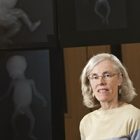
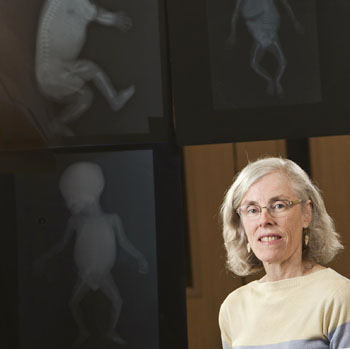
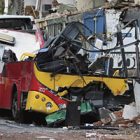
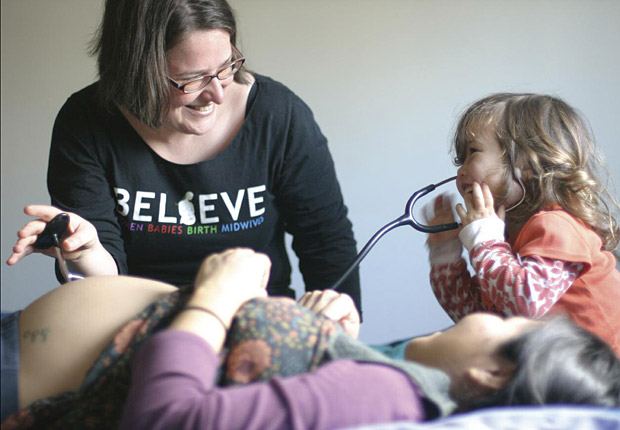 When Japhy was born on March 5, 2011, he was welcomed by his mother and father and sleepy big sister, 2½-year-old Maya, who kept herself awake for her brother’s late-night debut by watching videos.
When Japhy was born on March 5, 2011, he was welcomed by his mother and father and sleepy big sister, 2½-year-old Maya, who kept herself awake for her brother’s late-night debut by watching videos.

